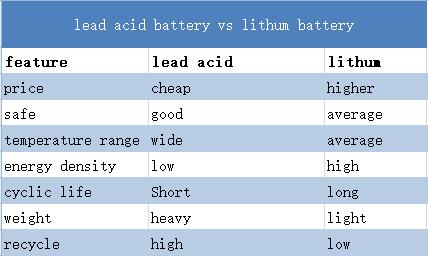Lead acid batteries and Lithium-ion batteries have their own advantages and disadvantages, which complement each other. The following article will introduce and compare the two types of batteries.
LEAD ACID BASICS
Lead acid has been around for more than a century and will be a market force for the foreseeable future due to its low cost and established manufacturing base. Lead acid batteries can be divided into two distinct categories: flooded and sealed/valve regulated (SLA or VRLA). The two types are identical in their internal chemistry . The most significant differences between the two types are the system level design considerations. Flooded lead acid batteries require three things that VRLA don’t: 1. Upright orientation to prevent electrolyte leakage 2. Ventilated environment to diffuse gases created during cycling 3. Routine maintenance of electrolyte Due to these differences, the lower cost of flooded lead acid must be balanced against the added complexity and secondary costs. VRLA batteries are divided into two categories: Gel and Absorbed Glass Mat (AGM). The different names reflect different methods of containing the electrolyte. In Gel batteries, a thickening agent is added to turn the electrolyte from liquid to gel. In AGM cells, a glass matrix is used to contain the liquid electrolyte. “Deep cycle” and “shallow cycle” lead acid batteries can be found in both the VRLA and flooded classes. Shallow cycle VRLA batteries are commonly used for automotive start, light, ignition (“SLI”) batteries that must deliver high power pulses for short durations. The stationary power market uses deep cycle since the batteries will often discharge at a low rate over the course of multiple hours.
LITHIUM ION BASICS
The concept of a lithium-ion battery was initially conceived in the 1970’s and began to see widespread adoption by the 1990’s. All lithium-ion cells are “deep cycle” meaning that they have the ability to be fully charged and discharged. The life of the battery will significantly increase if the depth of each discharge is limited to 80% of the rated capacity.
COMPARISON OF LITHIUM ION AND LEAD ACID BATTERY
Lead-acid batteries are widely used because of their safety, low price, low temperature resistance (-40c VS -25c), mature and reliable technology, and the establishment of a recycling industry system. The lithium ion batteries have many advantages too. They have a higher energy density per unit weight (3x) and volume (6x). Faster charging time, withstand higher temperature (140f VS 80f).

We are here to help you! If you close the chatbox, you will automatically receive a response from us via email. Please be sure to leave your contact details so that we can better assist